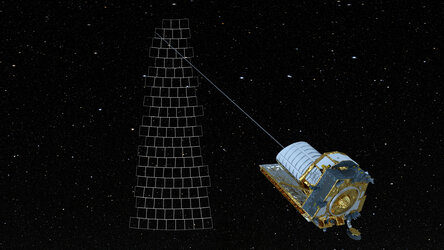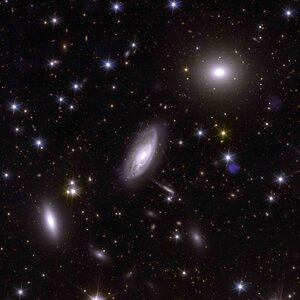Accept all cookies Accept only essential cookies See our Cookie Notice

About ESA
The European Space Agency (ESA) is Europe’s gateway to space. Its mission is to shape the development of Europe’s space capability and ensure that investment in space continues to deliver benefits to the citizens of Europe and the world.
Highlights
ESA - United space in Europe
This is ESA ESA facts Member States & Cooperating States Funding Director General Top management For Member State Delegations European vision European Space Policy ESA & EU Responsibility & Sustainability Annual Report Calendar of meetings Corporate newsEstablishments & sites
ESA Headquarters ESA ESTEC ESA ESOC ESA ESRIN ESA EAC ESA ESAC Europe's Spaceport ESA ESEC ESA ECSAT Brussels Office Washington OfficeWorking with ESA
Business with ESA ESA Commercialisation Gateway Law at ESA Careers Cyber resilience at ESA IT at ESA Newsroom Partnerships Merchandising Licence Education Open Space Innovation Platform Integrity and Reporting Administrative Tribunal Health and SafetyMore about ESA
History ESA Historical Archives Exhibitions Publications Art & Culture ESA Merchandise Kids Diversity ESA Brand Centre ESA ChampionsLatest
Space in Member States
Find out more about space activities in our 23 Member States, and understand how ESA works together with their national agencies, institutions and organisations.
Science & Exploration
Exploring our Solar System and unlocking the secrets of the Universe
Go to topicAstronauts
Missions
Juice Euclid Webb Solar Orbiter BepiColombo Gaia ExoMars Cheops Exoplanet missions More missionsActivities
International Space Station Orion service module Gateway Concordia Caves & Pangaea BenefitsLatest
Space Safety
Protecting life and infrastructure on Earth and in orbit
Go to topicAsteroids
Asteroids and Planetary Defence Asteroid danger explained Flyeye telescope: asteroid detection Hera mission: asteroid deflection Near-Earth Object Coordination CentreSpace junk
About space debris Space debris by the numbers Space Environment Report In space refuelling, refurbishing and removingSafety from space
Clean Space ecodesign Zero Debris Technologies Space for Earth Supporting Sustainable DevelopmentLatest
Applications
Using space to benefit citizens and meet future challenges on Earth
Go to topicObserving the Earth
Observing the Earth Future EO Copernicus Meteorology Space for our climate Satellite missionsCommercialisation
ESA Commercialisation Gateway Open Space Innovation Platform Business Incubation ESA Space SolutionsLatest
Enabling & Support
Making space accessible and developing the technologies for the future
Go to topicBuilding missions
Space Engineering and Technology Test centre Laboratories Concurrent Design Facility Preparing for the future Shaping the Future Discovery and Preparation Advanced Concepts TeamSpace transportation
Space Transportation Ariane Vega Space Rider Future space transportation Boost! Europe's Spaceport Launches from Europe's Spaceport from 2012Latest

Euclid's treasure trove
Thank you for liking
You have already liked this page, you can only like it once!
By observing more than a third of the sky during its mission, ESA’s Euclid will provide a gigantic catalogue of billions of galaxies and stars. This will be a treasure trove of data that can be used to improve our understanding of many aspects of astronomy: from merging galaxies to the physics of small and cool stars.
Euclid has a four times higher resolution, and 15 times better sensitivity in the near-infrared than is possible from current ground-based surveys. For each galaxy in Euclid’s detailed three-dimensional map, we will know its shape, mass, and other properties such as an estimate of how many new stars it produces per year.
In the ‘nearby’ Universe, out to a distance of around 16 million light-years, Euclid will even be able to see which types of stars each galaxy hosts, and how these stars orbit around their galaxy centre. This will teach us about how different galaxies form.
Although the largest fraction of its observations will be devoted to a wide survey, Euclid will spend about ten percent of its time looking at just three patches of the sky. These regions are called the Euclid Deep Fields. By staring at these patches, Euclid will be able to see objects that are hundreds of times fainter than the ones ESA’s Gaia can detect. Two of these regions were chosen to overlap with Hubble ‘deep field’ measurements, while the third has been specially selected for Euclid.
Since 2013, ESA's Gaia mission has been producing a gigantic survey of almost two billion stars in the Milky Way. Euclid will augment this survey. Unlike Gaia, Euclid will also observe near-infrared light and will be able to spot the brown dwarfs and ultra-cool stars that Gaia will miss.
In addition to detecting new objects, Euclid will provide complementary information for stars that have already been observed by Gaia. It will measure infrared colours and spectra for these objects. This new information will allow astronomers to calculate the precise age and initial chemical composition of each star. This is crucial for determining how the heavier chemical elements have built up in our galaxy.
Euclid is ESA’s space telescope designed to explore the dark Universe. The mission will create the largest, most accurate 3D map of the Universe ever produced across 10 billion years of cosmic time. Euclid will explore how the Universe has expanded and how large-scale structure is distributed across space and time, revealing more about the role of gravity and the nature of dark energy and dark matter.
-
CREDIT
ESA (acknowledgement: work performed by ATG under contract to ESA) -
LICENCE
CC BY-SA 3.0 IGO or ESA Standard Licence
(content can be used under either licence)

Euclid’s wide and deep surveys

Euclid is back – 26 million galaxies and counting

Euclid’s mosaic on Gaia and Planck sky map

How Euclid scans the sky















 Germany
Germany
 Austria
Austria
 Belgium
Belgium
 Denmark
Denmark
 Spain
Spain
 Estonia
Estonia
 Finland
Finland
 France
France
 Greece
Greece
 Hungary
Hungary
 Ireland
Ireland
 Italy
Italy
 Luxembourg
Luxembourg
 Norway
Norway
 The Netherlands
The Netherlands
 Poland
Poland
 Portugal
Portugal
 Czechia
Czechia
 Romania
Romania
 United Kingdom
United Kingdom
 Slovenia
Slovenia
 Sweden
Sweden
 Switzerland
Switzerland
























